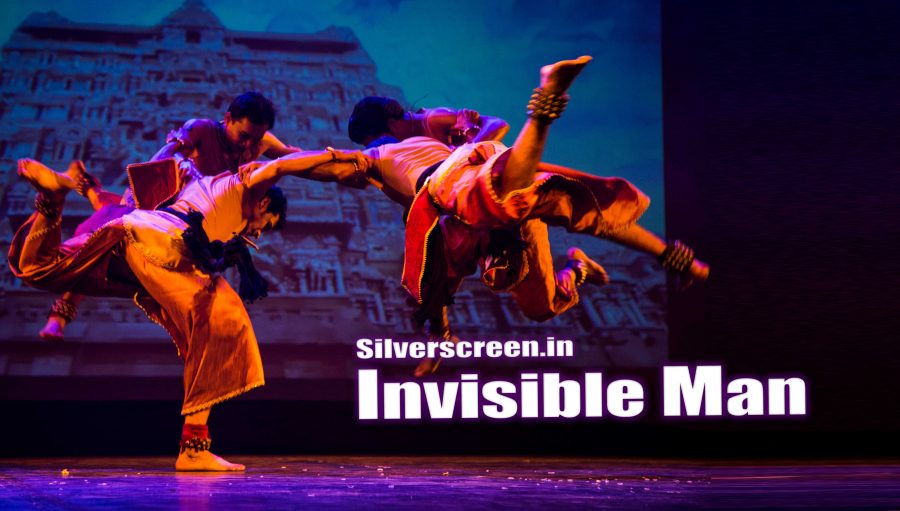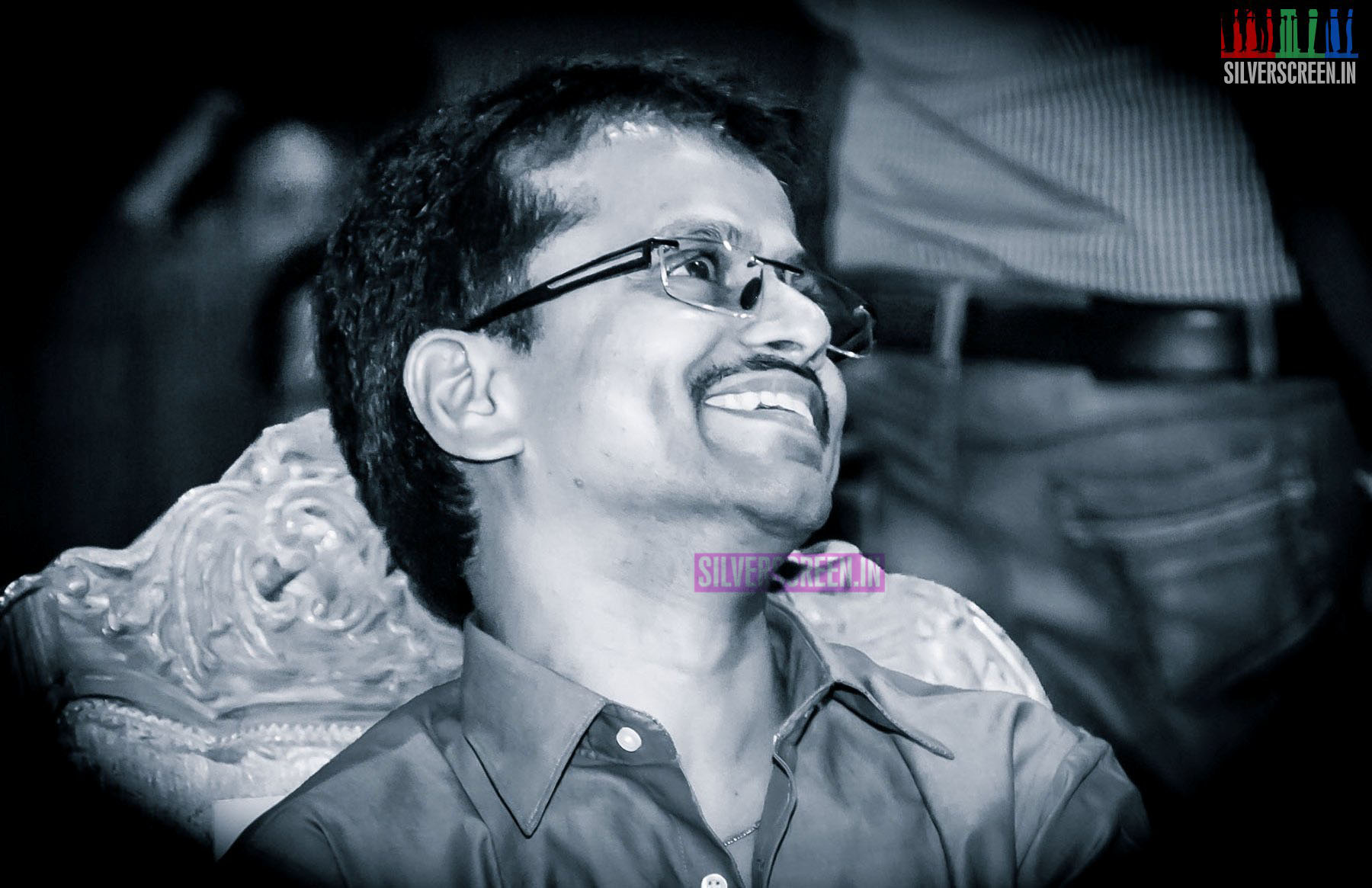Despite director KV Anand’s heads up that a Silverscreen writer was going to get in touch with him, 21-year old Assistant Director Thribhuvan Vijay’s voice over the phone sounds sceptical: “Are you sure? What do you want to talk to me about?”
Well, it’s his first interview.

IMG_2179
‘Right, right,’ he says doubtfully. We press the recorder. His eyes widen, “Oh! You’re going to record this?” My fingers twitch over the red button as I say slowly, ‘Only if that’s okay with you.’ Right, right. A deep breath and a nervous swallow. And then it begins:
Take 1: The road not taken

“I was all set to go abroad and get my aeronautical engineering degree. But somehow, it didn’t appeal to me. I’m 21, and I wanted to take this risk. I don’t want to have any regrets in life. If this doesn’t work out, I can always go back to engineering. It’s not going anywhere,” he smiles impishly, relaxing for the first time.
“I would go around the directors’ offices all the time. Whenever they saw me, they would ask,“Ethukku? Ithellam venama?” But I was determined. Then one day, my mom came across this short film competition. I ended up making two short films on disability. That’s when I realised that I had a natural flair for it. I thought to myself – here I am without any training, no reading material, nothing. And I’m making a bit-film with a local wedding videographer in Pondicherry. Can you imagine how encouraged I felt when professional guys in the field had good things to say about it?
“My uncle introduced me to KV Anand. See, it works like this. Assistant directors visit the sets. They’re told to submit an application form and a short film CD. There are endless reasons for why someone accepts you or rejects you. It’s just the director’s call.
“I showed KV sir my film, and he said, ‘Why don’t you write some articles?’ He even had a topic ready—‘How would India have been under communist rule?’
“So I wrote. What followed was a series of email discussions. His advice to me was: ‘Be less opinionated. Think outside the box.’ Then he wanted me to write montages. I did everything he said. But after some time, the communication ceased. For an entire month. Can’t tell you how freaked out I was,” he says with a rueful shake of his head. “Then on Diwali morning, I got a call from him, ‘Vijay, have you joined elsewhere? Illeya? Seri, bring your laptop and come.’ Phew!”
Take 2: The first steps
Vijay learned some simple but profound lessons on the sets of his first film: “Find your way around. Get involved. Take charge. Make mistakes. Learn. Or be the odd man out.” He understood that this was a job without any guidelines. There was no rule book. You simply learned on the job.
Vijay was one of four Assistant Directors (ADs). His job was to take charge of the costumes and co-ordinate with junior artists. Vijay realised he could get great advice from his seniors. One of them was Yamurukey Bayamey director DK—“He put me on track. He didn’t tell me anything. He just showed me how to direct.”
Take 3: So what exactly does an AD do?
In a word? “Be a shock absorber,” says Vijay. “You’re in charge of the nitty-gritties–shooting schedule, props, ensuring that artists are on time. And the golden unwritten rule on the sets is—don’t give your director the bad news. None of these minor mishaps should reach his ears.” A good AD team ensures that the director is not in the line of fire at any point—“Come on, he’s already under lot of pressure—project funding, call sheets, 9-6-6-7, shot selection, briefing lead actors. And you can’t possibly go and tell him that the piano has been stolen,” laughs Vijay.

editing
What about scripting sessions? Does he have a say in it? He says the script and story are mostly discussed by the director and the writer. Of course he’s welcome to share his input. “Ideally most directors work with a bound script. KV sir likes to improvise at the last minute. It’s a gamble at the end of the day.”
An AD also helps research a script. During Mattran for instance, Vijay spoke to doctors to learn more about the surgery involved. Then there are the foreign shoots. He remembers a shoot at Lapia for Mattran: “The firangs were gobsmacked to see the way we used to shoot. We would simply take things in the environment and use them. Move that dustbin to the left, remove that red car, make that man run on the road. Take continuous shots without a break. And they would come with time charts—9:00 am–shot 1, 9:15–shot 2. We found it absurd. We can only work in complete chaos.”
Bollywood, he admits, chalks out an orderly movie schedule, from pre-production to the release date. Tamil cinema has a more flexible time frame. An unexpected downpour will be met with perfect calm—either have a montage or create a new scene.
During Maatran he graduated from junior to 3rd AD. That meant he took care of the edits and visual effects. KV’s team had an eclectic choice of ADs. There would be someone familiar with Tamil linguistics, a Tamil writer, a reporter from a Bangalore daily. What did they do best? Play perfect crisis managers.
Take 4: Your bread-and-butter?
How profitable is the trade? Not very, he says. You don’t have an income after a movie is over. You get per day baata and you get an official salary check. And the director decides. So he would pick Rs.75/- on a non-shooting day and Rs.150/- on shooting days. Vijay adds a cursory warning, “This line of work is not suitable for married men. Get married only if you can handle the stress and low pay.” It’s a director’s prerogative to choose the number of ADs he wants. A big budget film needs a team of ADs while a small budget film can do with even one. “That one AD just needs to be the king of the show,” Vijay grins.
Take 5: So what does a typical workday look like?
An AD has a crammed schedule. It’s not just about making sure the shot has all its nuts and bolts together. It’s about ensuring that the director has the right milieu to put his thoughts into the frame. Along with production managers, ADs are the first to report on the sets. Vijay is in constant touch with the director. Things move at lightning speed. Once the caravan arrives, costumes are handed to the artists. ADs have to keep a tab on everything, from make-up to food to camera equipment. There’s a bucket list of shots to be taken from the director—master shot, finishing shot. Another crucial chore is to clear the set after a shot. Or in pure AD parlance—clear the mess. And by the time the camera shifts from one angle to the next, they would have moved away the vehicles, chairs, lights, and stands. Once the camera is faced on that axis, all the shots should be covered on that axis, he says.
ADs also look out for continuity shots and props. “A dance sequence would have a blow-fan for the hero’s hair to fly. The first take might look ok. Then you notice that the hair has fallen over his face and you point it out to the director.”
Once the shoot starts, ADs train background artists with their lines. “I write it down on a piece of white paper, tell them to learn it by heart, and give a modulation to it—anger, sadness, humour.”
Even the dialogue sheets for lead actors are handed to the AD. Vijay admits that their task is quite laborious if the artist is from the North. “Everything is given in phonetics. I teach them pronunciation. In case they falter, I prompt on the spot. At times, there are some hilarious moments. Our heroes usually know Tamil, avanga poyittey irrukingey. But often our heroines can’t speak Tamil.” He grins, “They take their own sweet time to get it right. Like ‘naan nalla irukkey’. But they end up with ‘naan nalla irukku’. They won’t get that finesse. You can easily find that in their lip sync.”
Vijay suddenly bursts into animation—“Can you imagine the editor’s plight? I mean, he’s hearing the heroine’s and the AD’s voice. It’s quite a task to sync it all properly.”
Then comes the background placements, after the director gives them the camera positions. Troll the car, park the auto nearby, make a few people walk over the pavement. Of course, everything needs to be approved by the director—“I actually like that part, setting up a shot. The camera is usually moving and you have to match the timing of the artist walking around with the background.”
Take 6: Scheduling, props and budget
Scheduling is another important duty. Before a shoot, ADs chalk out the entire schedule with the production manager. They make a list of everything, from props to special equipment (piano, air blower, or even an industrial crane for stunt scenes). Another list is handed out on the day of the shoot, along with reporting time and make-up time. Vijay has to give an estimated list of junior artists required per day to the director.
What about location hunting? “Yes, that we do even before the director puts out the first schedule.” In detail-intensive areas like an underwater sequence, he takes along an assistant camera man. He describes the brief—a rich hero’s house, a middle-class heroine’s flat, a police station, a Shiva temple. What about foreign shoots? Usually the cameraman, director and art director scout for those locations. Not that the AD gets to relax during a foreign shoot. The entire crew’s reigns are handed over to him. He coordinates with junior artists. The requirements will run like this—Five Chinese males, 18-22. There are even various cadres, he informs me. Rich girls, models, senior citizens. Each category costs different. The better they look, the higher the rate.
“At times junior artists are instructed to bring their own costumes, such as for temple scenes, where the artist bring their own iruntha, veshti ketti vaa…appadi.” Vijay is also involved in the casting of side characters, like a constable, a nurse, etc.
Take 7: Stunts and dancing
Recommended
ADs are also involved in song sequence. There’s a simple requirement. Look for any missing beats in the song. When you split the song, make sure every beat is filled. At times small beats are missed, and you can take an extra shot there—a head nod or even lightly rapping a flower on the heroine—“I put the shot division in such a way that none of these are missed.”
For stunt scenes, they keep a check on continuity and ensure that there are no hassles on the sets. Most of the time, ADs are hiding in plain sight in a frame while a take is in progress. They even dress up as a junior artist and move around in the frame, controlling other junior artists to ensure continuous activity on frame. Sometime they hide behind an object, prompting the artists. “We are always there, not just behind the camera, even in front of it. We also play the dummy actor and enact the entire scene before the main artists take their place. It helps in discussing camera angles and camera positions.” Ubiquitous gets a whole new meaning when it comes to an AD’s role in a film.
Take: It Away

IMG_2185
*****
‘Interview: Assistant Director Thribhuvan Vijay’ is a Silverscreen original article. It was not paid for or commissioned by anyone associated with the industry. Silverscreen.in and its writers do not have an advertising relationship with any of the personalities featured on the site.



